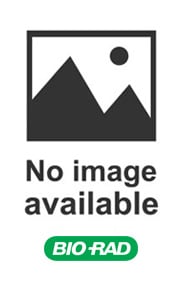C1q antibody | 004-43.X (3R9/2)

Mouse anti Human C1q
- Product Type
- Monoclonal Antibody
- Clone
- 004-43.X (3R9/2)
- Isotype
- IgG1
- Specificity
- C1q
| Mouse anti human C1q antibody, clone 004-43.X (3R9/2), recognizes human complement component 1 q (C1q), a ~156 kDa secreted protein. C1q associates with proenzymes C1r and C1s to form the calcium-dependent C1 complex, the first component of the serum complement system. C1q is composed of six A-, six B-chains and six C-polypeptide chains. Each chain contains a collagen-like region located near the N-terminus and a C-terminal globular region. These regions bind the Fc region of IgM and IgG molecules, initiating the classical pathway of complement activation. C1q deficiency has been associated with lupus erythematosus and glomerulonephritis (Troedson et al. 2013). |
- Target Species
- Human
- Product Form
- Purified IgG - liquid
- Preparation
- Purified IgG prepared by affinity chromatography on Protein A from ascites
- Buffer Solution
- Borate buffered saline
- Preservative Stabilisers
- <0.1% Sodium Azide (NaN3)
- Immunogen
- Globular head domain of C1q, purified from human plasma.
- Approx. Protein Concentrations
- Current, batch-specific concentration 1.1 mg/ml
- Regulatory
- For research purposes only
- Guarantee
- Guaranteed until date of expiry. Please see product label.
Avoid repeated freezing and thawing as this may denature the antibody. Storage in frost-free freezers is not recommended.
| Application Name | Verified | Min Dilution | Max Dilution |
|---|---|---|---|
| ELISA | |||
| Flow Cytometry | |||
| Immunofluorescence | |||
| Immunohistology - Frozen | 1:500 | 1:1000 | |
| Western Blotting |
- Histology Positive Control Tissue
- Kidney from patients with streptococcal glomerulonephritis
| Description | Product Code | Applications | Pack Size | List Price | Your Price | Quantity | |
|---|---|---|---|---|---|---|---|
| Mouse IgG1 Negative Control | MCA928 | F | 100 Tests |
|
Log in | ||
| List Price | Your Price | ||||||
|
|
Log in | ||||||
| Description | Mouse IgG1 Negative Control | ||||||
References for C1q antibody
-
Castellano, G. et al. (2010) Therapeutic targeting of classical and lectin pathways of complement protects from ischemia-reperfusion-induced renal damage.
Am J Pathol. 176: 1648-59. -
Ma, W. et al. (2012) RAGE binds C1q and enhances C1q-mediated phagocytosis.
Cell Immunol. 274: 72-82. -
Lachmann, N. et al. (2013) Systematic comparison of four cell- and Luminex-based methods for assessment of complement-activating HLA antibodies.
Transplantation. 95 (5): 694-700. -
Cai, Y. et al. (2015) C1q protein binds to the apoptotic nucleolus and causes C1 protease degradation of nucleolar proteins.
J Biol Chem. 290 (37): 22570-80. -
Madhukaran, S.P. et al. (2015) Decidual expression and localization of human surfactant protein SP-A and SP-D, and complement protein C1q.
Mol Immunol. 66 (2): 197-207. -
Kashiwagi, N. et al. (2017) Method for measuring anti-drug antibody
US Patent Application US20170315118A1
Further Reading
-
Petry, F. (1998) Molecular basis of hereditary C1q deficiency.
Immunobiology. 199 (2): 286-94. -
Schejbel, L. et al. (2011) Molecular basis of hereditary C1q deficiency--revisited: identification of several novel disease-causing mutations.
Genes Immun. 12 (8): 626-34.
- Synonyms
- Complement Component 1q
- RRID
- AB_2067258
- UniProt
- P02745
- P02746
- P02747
- Entrez Gene
- C1QA
- C1QB
- C1QC
- GO Terms
- GO:0005602 complement component C1 complex
- GO:0006958 complement activation, classical pathway
- GO:0007267 cell-cell signaling
- GO:0045087 innate immune response
- GO:0005576 extracellular region
- GO:0030853 negative regulation of granulocyte differentiation
- GO:0045650 negative regulation of macrophage differentiation
Please Note: All Products are "FOR RESEARCH PURPOSES ONLY"
View all Anti-Human ProductsAlways be the first to know.
When we launch new products and resources to help you achieve more in the lab.
Yes, sign me up